There are 33 ethnic minority groups in Zhangjiajie. Among these groups, the Tujia ethnic minority has the most population, with a total number of 1.02 million. The Tujia ethnic minority is an ancient ethnic group. Their ancestors have been living in the western part of Hunan since 2,000 years ago. The Tujia ethnic minority has their own language system, religious belief, unique cultures of food, costumes, architecture and art.
Zhangjiajie Tujia Folk Custom Park, or Zhangjiajie Tusi Imperial City is the best place to experience the daily life of the Tujia people and to get deep understanding of the Tujia historical culture and the characteristics of the Tujia people.
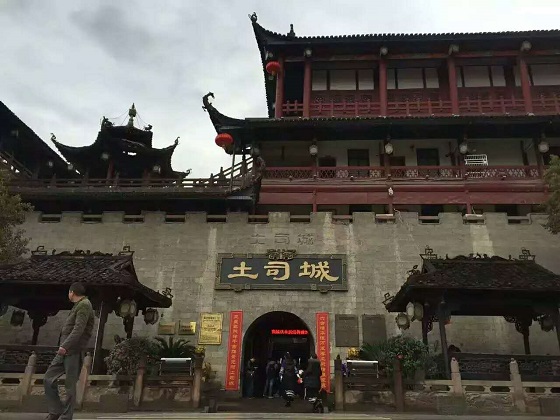 ☝ The Tusi Castle in Zhangjiajie Tujia Folk Custom Park
☝ The Tusi Castle in Zhangjiajie Tujia Folk Custom Park
Zhangjiajie Tujia Folk Custom Park , or Zhangjiajie Tusi Imperial City is located at Wuzi Slope, Nanzhuangping, Yongding District, Zhangjiajie. It connects the Tianmen in the south and Lishhui River in the north.
Zhangjiajie Tujia Folk Custom Park is only five minutes drive from the city center. In addition, it is roughly ten minutes drive from both the Zhangjiajie Hehua International Airport and Zhangjiajie Train Station. To drive from Zhangjiajie West Train Station, it takes around 10 minutes.
There are bus route 1, bus route 5, bus route 10, bus route 13, bus route 101 and bus route 102 going directly to Zhangjiajie Tujia Folk Custom Park or the Tusi Imperial City from the downtown. In one word, it is very convenient to go to this place.
Zhangjiajie Tujia Folk Custom Park or Zhangjiajie Tusi Imperial City opens from 8 am to 5 pm Monday to Sunday. Without special reason, it opens all year round.
Entry ticket price for Zhangjiajie Tujia Folk Custom Park or Zhangjiajie Tusi Imperial City is CNY 120 Yuan per person. It is free of charge to babies, the elderly who are more than 70 years old. Half price tickets are available to children, youth and college students.
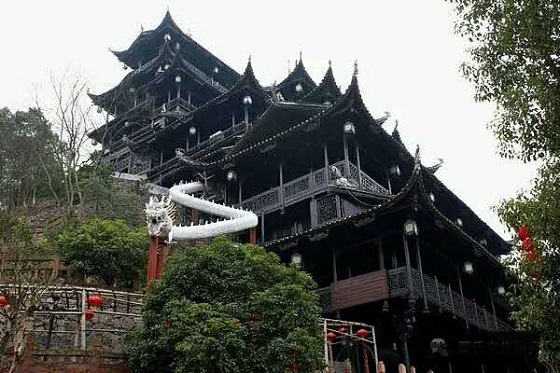 ☝ The 9-storied Hereditary Hall (九重天世袭堂) in Zhangjiajie Tujia Folk Custom Park
☝ The 9-storied Hereditary Hall (九重天世袭堂) in Zhangjiajie Tujia Folk Custom Park
Zhangjiajie Tujia Folk Custom Park or Zhangjiajie Tusi Imperial City is where visitors can travel around, watch shows, attend exhibitions and eat. It is formed by two major parts: the Tusi Castle and the Bizika Holy Fire Hall. The Tujia people call themselves as Bizika, and the Bizka Holy Fire Hall is the venue to host all kinds of ethnic song and dance performances.
Also known as Tuguan, Tuqiu, Tusi is a general term used to call the head of the ethnic minority group. As a part of the Chinese official ranking system, the Tusi system incepted in the period of the Five Dynasties and Ten Kingdoms. Among the ethnic tribes, the king of Tusi has supreme power and authority. The Tujia Castle in the Tujia Customs Park of Zhangjiajie Tusi Imperial City was originally built by Tusi King Qin Chunyi in the eighth year of Yongzheng (1730) of Qing Dynasty. The entire Tusi Castle is 120 acres and is very magnificent. There are a large number of cultural relics collected and thus it boasts as the South China Forbidden City.
Surrounded by thick stone walls, the Tusi Castle has the 9-storied Hereditary Hall as the best part. The Nine Storied Hereditary Hall actually has 12 floors inside. Built on an 80 degree slope, it is 48 meters tall. The entire building is connected by innumerous wooden bolts without using an iron nail and thus it is regarded as a miracle in the history of Tujia architecture. The Hereditary Hall was written in the Guinness Records as the largest, tallest and the most perfect wooden structure stilted building in September 2002.
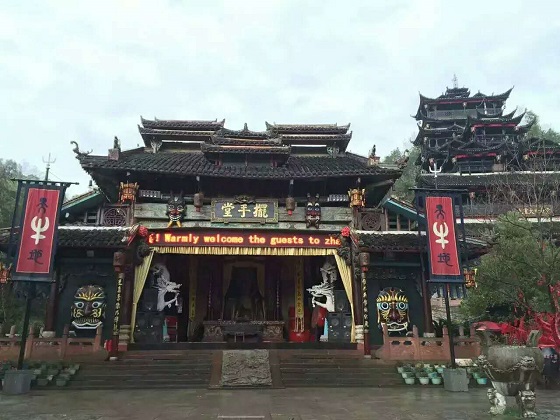 ☝ The Hand-Swinging Hall in Zhangjiajie Tujia Folk Custom Park
☝ The Hand-Swinging Hall in Zhangjiajie Tujia Folk Custom Park
The Nine Storied Hereditary Hall is a museum of Tujia folk customs with several sub-halls inside. There is a Zuyuan Hall that introduces the origin, evolution and geographical distribution of Tujia ethnic group. There is a Shengxi Hall that introduces the weaving and embroidery, traditional costumes and living utensils of Tujia ethnic group. There is a Gengzhan Hall that introduces to visitors tools and weapons that Tujia ancestors used crossing various civilizations from nomadism, fishing and hunting to farming. There is a Yizheng Hall showcasing statue of Qin Chunyi who was the last Tusi king, memorial spirit tablets of successive Tusi kings in Wuling mountainous area in the history and Nuo masks which are props used by Tujia ancestors for totem worship. There is a Zhengqi Hall showcasing deliberate wood carving windows and furniture from the Ming Dynasty, Qing Dynasty to recent modern times. Enze Hall, on the other hand, shows the elegant furniture and displays in the rooms of the daughters or the princesses of Tusi King.
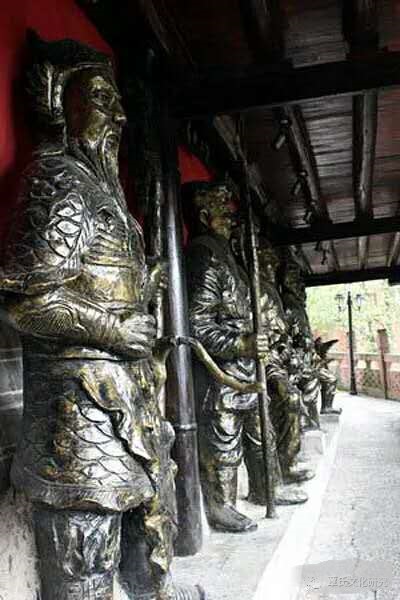 ☝ Bronze Statues of Tujia soliders in Gengzhan Hall
☝ Bronze Statues of Tujia soliders in Gengzhan Hall
To build the Nine Storied Hereditary Hall, 1008 wood posts and 10088 square wood columns were used.
❶ Dizhu Pavillion: This is a pavilion supported by five giant pillars with each representing Gods of Land from five directions including the North, the South, the East, the West and the Central. On the pillars carved the figures of the most respected ancestors of the Tujia ethnic group such as the Lin emperor of Ba Country, the Lord Peng, Official Xiang, Hero Tian and Tusi King Qin Hou, with a good wish that the Gods of Land from five directions will protect and bless the descendants of the Tujian.
❷ Taiwan Tiger Inscription: Tujia ethnic group worships the white tiger. The Chinese character of the Tiger on this inscription was written by Liu Mingdeng, a general from Tujia ethnic group, who was regional Taiwan military commander in the sixth year of Tongzhi in 1867 during Qing Dynasty. It is said when leading the war in Taiwan, there was a sudden storm, and general Liu wrote the character Tiger in order to stop the storm. In Chinese traditional culture, Tigers are good at slowing down the wind and storm. On the inscription, the letter Tiger is 100 cm tall and 40 cm wide. The stone the Tiger word written on is 126 cm tall and 75 cm wide. The former Tiger Inscription is stored on Caoling Historic Trail, New Taipei, Taiwan, China. Here is the replicate of the original copy.
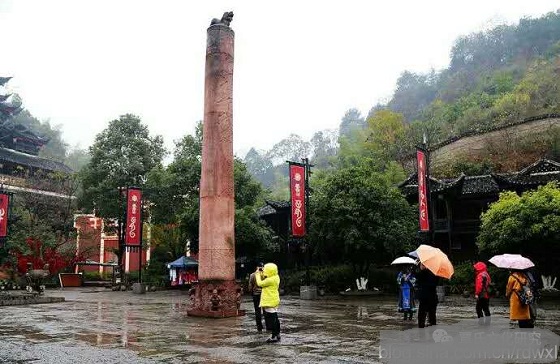 ☝ Zhangjiajie Tujia Folk Custom Park
☝ Zhangjiajie Tujia Folk Custom Park
❸ Top Award of the Southeast China: It is the largest stone arch in regions south of the Yangtze River. During the Jiajing period in the Ming Dynasty, Japanese pirates invaded China southeastern coastal areas and the imperial army was not strong enough to defeat them. The King of Tusi of the West Hunan enrolled 30,000 soldiers and lead the troop and traveled thousands of miles to fight against the Japanese pirates. After four years of fierce fighting, the troop led by Tusi King successfully defeated the pirates. The Emperor Jiajing awarded the Tusi King and his brave Tujia soldiers with the Top Award of Southeast China.
❹ Open Yard for Hand-Swinging Dance: It is the place where the Tujia descendants sacrifice to their ancestors with Hand-Swinging dance and Maogusi dance. Known as the "the living fossil of Chinese drama", the Maogusi dance is a very primitive and traditional dance inspired by the Tujia ethnic group. While dancing, men wear straw and women use leaves and bark to cover their bodies. These dances perfectly replay the scenarios of production and living of the Tujia ancestors.
❺ Tujia Mountain Fastness: Inside it, there are building for girls doing needlework, Sheba building, The Prince Pond and so on. The Tujia Mountain Fastness has very beautiful views.
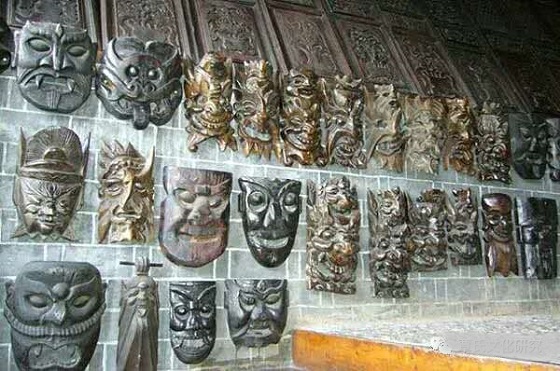 ☝ Nuo Masks in Yizheng Hall
☝ Nuo Masks in Yizheng Hall
Zhangjiajie Tusi Castle has collections of 308 carved wooden windows, 432 carved wooden panels, 318 carved wooden doors, 999 rock blocks, more than 5000 meters of red sandstone railings, more than 10,000 cultural relics as well as more than 500 local gazetteers and folk works.
Zhangjiajie Tusi Imperial city showcases the authentic culture, art and folk customs of Tujia ethic group. The tour to it can be short to 2 hours or long to 3 to 4 hours. After the tour, you can just go to the restaurant inside the Tusi Imperial city and have some yummy food to experience the Tujia culture in another aspect, isn't it interesting?